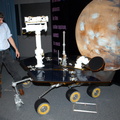
WIKIARCHIVES.SPACE
The Human Spaceflight Archive

Information
- Taken in
- Kennedy Space Center
- Autor
- NASA
- Opis
- A science briefing on the Mars Exploration Rover (MER) missions is held for the media at Kennedy Space Center. From left, the participants are Donald Savage, NASA Public Information Officer; Dr. Ed Weiler, Associate Administrator for Space Science, NASA Headquarters; Dr. Jim Garvin, Mars lead scientist, NASA Headquarters; Dr. Cathy Weitz, MER program scientist, NASA Headquarters; Dr. Joy Crisp, MER project scientist, Jet Propulsion Laboratory; and Dr. Steve Squyres, Mer principal investigator, Cornell Univeristy, Ithaca, N.Y. NASA's twin Mars Exploration Rovers are designed to study the history of water on Mars. These robotic geologists are equipped with a robotic arm, a drilling tool, three spectrometers, and four pairs of cameras that allow them to have a human-like, 3D view of the terrain. Each rover could travel as far as 100 meters in one day to act as Mars scientists' eyes and hands, exploring an environment where humans are not yet able to go. MER-A is scheduled to launch on June 8 at 2:06 p.m. EDT, with two launch opportunities each day during a launch period that closes on June 24.
- Utworzone
- piątek 6 czerwiec 2003
- Source link
- https://science.ksc.nasa.gov/gallery/photos/2003/
- Odwiedzin
- 37
- Ocena
- nieoceniane
- Oceń to zdjęcie
- License
- CC BY-NC-ND
- Modified by WikiArchives
- No (original)
- Pobrania
- 0
Powered by Piwigo


















